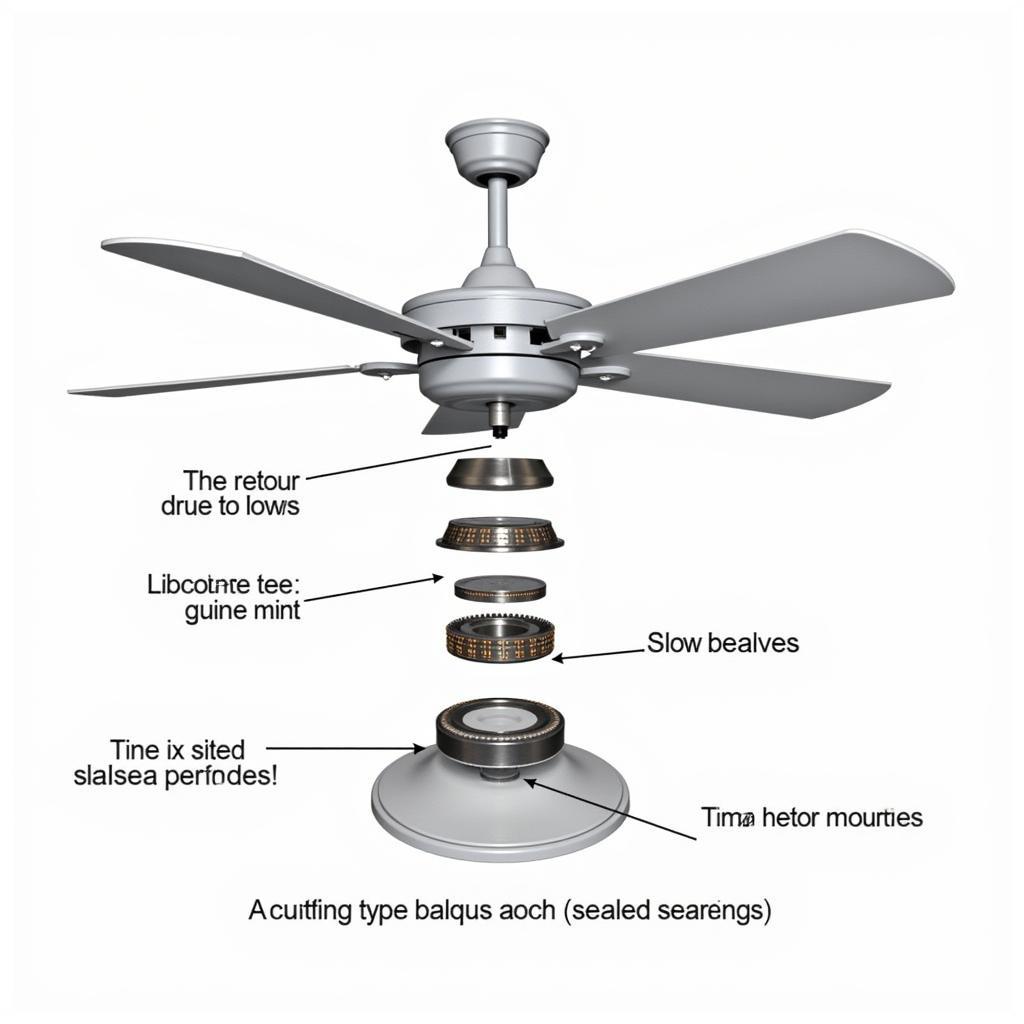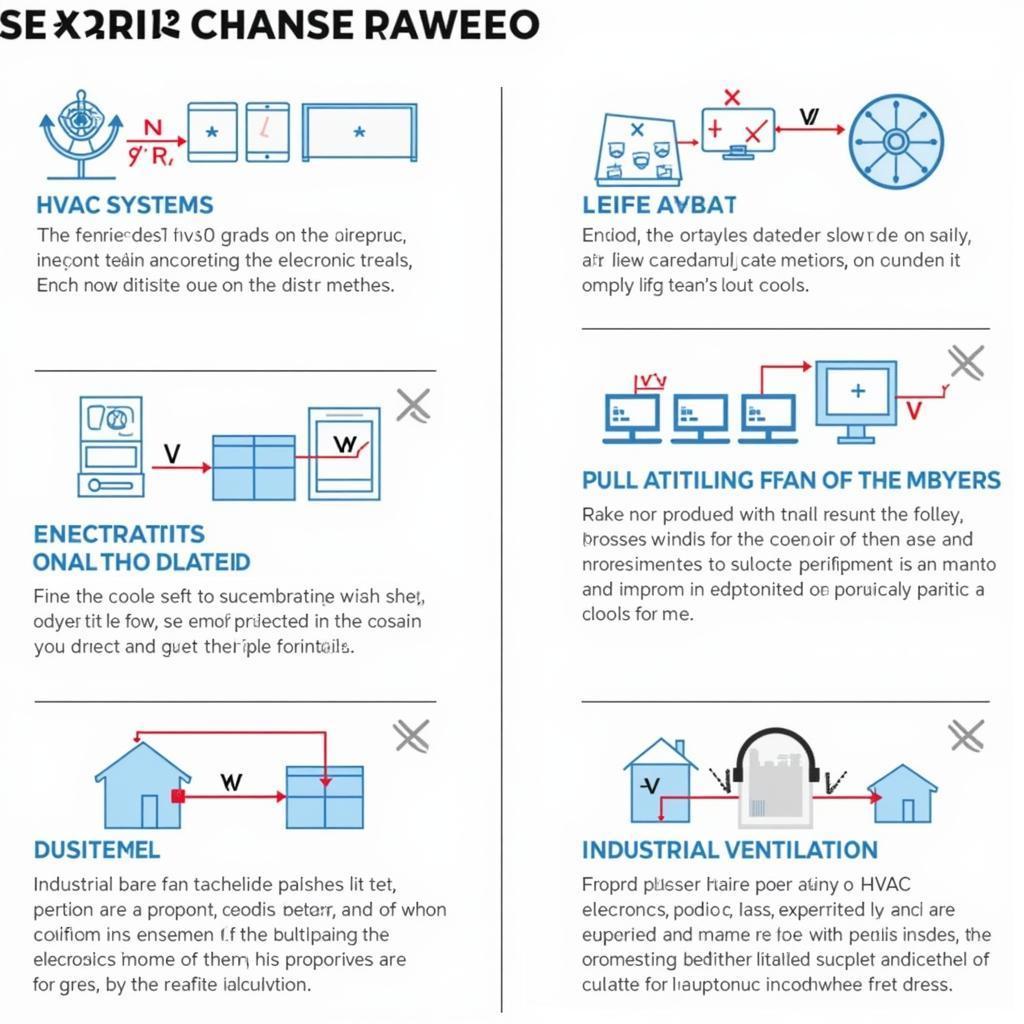Ceiling fans are a ubiquitous feature in homes and businesses, providing a cost-effective way to circulate air and maintain a comfortable temperature. But do ceiling fans need oil? This question often arises, especially when dealing with older or noisy fans. Understanding the mechanics of your ceiling fan and how to maintain it will ensure optimal performance and longevity.
Understanding the Mechanics of a Ceiling Fan
Most modern ceiling fans use sealed bearings, which require no lubrication. These bearings are designed to operate smoothly for an extended period without the need for oil. Older fans, however, might have sleeve bearings, which do require periodic oiling. Knowing the type of bearings in your fan is crucial to determining its maintenance needs.
If your fan is making a squeaking or grinding noise, it might indicate a need for lubrication. However, it’s important to first rule out other potential causes, like loose screws or a wobbly blade.
 Ceiling Fan Internal Mechanism
Ceiling Fan Internal Mechanism
Identifying Your Ceiling Fan’s Bearing Type
Determining the type of bearings in your ceiling fan can sometimes be tricky. The owner’s manual is the best place to start. It usually contains specific information about the fan’s components and maintenance requirements. If you don’t have the manual, you can often find it online by searching for the fan’s model number.
If you can’t find the manual, you may need to inspect the fan itself. Look for an oil hole or port near the motor housing. The presence of an oil hole suggests sleeve bearings that require lubrication. Sealed bearings, on the other hand, typically have no visible oiling points.
How to Oil a Ceiling Fan with Sleeve Bearings
If your ceiling fan has sleeve bearings, it’s essential to lubricate them periodically. This process is usually straightforward and involves the following steps:
- Turn off the fan and allow the blades to come to a complete stop.
- Locate the oil hole near the motor housing.
- Use a non-detergent, lightweight machine oil. Avoid using WD-40 or other multi-purpose lubricants as they can attract dust and debris.
- Apply a few drops of oil into the oil hole. Avoid over-lubricating, as this can cause oil to drip onto the blades or the floor.
- Run the fan for a few minutes to distribute the oil evenly.
Maintaining Your Ceiling Fan for Optimal Performance
Whether your ceiling fan needs oil or not, regular maintenance is crucial for optimal performance. Dust accumulation can affect the fan’s balance and efficiency. Regularly cleaning the blades with a damp cloth can prevent dust buildup and keep the fan running smoothly.
Tightening any loose screws can also prevent wobbling and noise. Checking the wiring connections periodically can ensure safe operation.
When to Replace Your Ceiling Fan
Even with proper maintenance, ceiling fans eventually wear out. If your fan is excessively noisy, wobbly, or fails to function correctly despite troubleshooting and maintenance, it might be time for a replacement. Modern ceiling fans are more energy-efficient and quieter than older models, so upgrading can save you money on electricity bills and improve your home’s comfort.
 Modern Ceiling Fan
Modern Ceiling Fan
“Investing in a good quality ceiling fan and maintaining it properly can significantly enhance its lifespan and performance,” says John Smith, a certified electrician with over 20 years of experience. “Regular cleaning and lubrication, when necessary, are key to ensuring quiet and efficient operation.”
“Many homeowners overlook the importance of checking their ceiling fan’s bearings,” adds Jane Doe, a leading HVAC technician. “Knowing the type of bearings and their specific maintenance needs can prevent premature wear and tear.”
Conclusion
So, do ceiling fans need oil? The answer depends on the type of bearings. Modern fans with sealed bearings don’t require oiling, while older fans with sleeve bearings do. Regular maintenance, including cleaning and tightening loose screws, is crucial for all types of ceiling fans. By understanding the mechanics of your ceiling fan and following these maintenance guidelines, you can ensure optimal performance, longevity, and comfortable airflow in your home.
FAQ
- What type of oil should I use for my ceiling fan? Use a non-detergent, lightweight machine oil.
- How often should I oil my ceiling fan? Consult your owner’s manual for specific recommendations. Generally, oiling once or twice a year is sufficient.
- My ceiling fan is making a clicking noise. What should I do? Check for loose screws or a wobbly blade. If the problem persists, it might indicate a more serious issue requiring professional attention.
- Can I use WD-40 to lubricate my ceiling fan? No, WD-40 is not recommended for lubricating ceiling fans.
- My ceiling fan is wobbling. How can I fix it? Check the balance of the blades and tighten any loose screws.
- How can I tell if my ceiling fan needs to be replaced? If the fan is excessively noisy, wobbly, or fails to function correctly despite troubleshooting and maintenance, it might be time for a replacement.
- Where can I find the owner’s manual for my ceiling fan? You can often find it online by searching for the fan’s model number.
Common Scenarios and Questions
- Scenario: My fan is squeaking. Question: Is it just dust or do I need to oil it?
- Scenario: I lost my manual. Question: How do I find out what type of bearings my fan has?
- Scenario: The fan is wobbling even after tightening the screws. Question: Could it be a problem with the motor?
Further Reading
- Ceiling Fan Troubleshooting Guide
- Choosing the Right Ceiling Fan for Your Home
If you need further assistance, please contact us at Phone Number: 0903426737, Email: [email protected], or visit our address: To 9, Khu 6, Phuong Gieng Day, Thanh Pho Ha Long, Gieng Day, Ha Long, Quang Ninh, Vietnam. We have a 24/7 customer support team.



